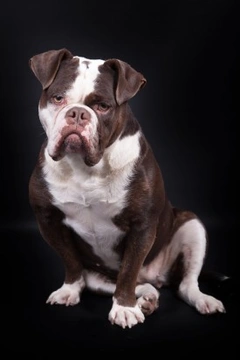
What is an Olde Tyme bulldog?
Everyone is familiar with the British or English bulldog, and this breed of dog is actually widely recognised as the national dog of England. While the bulldog is not as common a sight today as they used to be, nevertheless, the bulldog is still a popular pet with a dedicated following of owners and enthusiasts.
However, if you were to rank dog breeds according to those that are most likely to suffer from health problems downwards, the British bulldog would almost certainly be top of the list. The modern bulldog is prone to a wide range of problems with their health and conformation which can make them challenging to breed and care for, and may even shorten their lives.
The modern bulldog that we think of as the pedigree and most common form of bulldog actually bears very little resemblance to the bulldog appearance from just a couple of centuries ago, and this change has occurred largely due to the results of long term selective breeding for certain breed traits.
Many dog lovers and bulldog enthusiasts do not approve of this, both due to the fact that it is an engineered change, and because of the health implication for dogs of the breed. This in its turn has led to a resurgence in popularity and demand for bulldogs that maintain a more traditional appearance like the bulldogs of old, and has led to deliberate breeding efforts to produce a variant bulldog, which is known as the Olde Tyme bulldog.
If you are not quite sure what an Olde Tyme bulldog is or how to tell one from a standard bulldog, in this article we will look into the breed in more detail, and compare the Olde Tyme bulldog to the standard British bulldog. Read on to learn more.
How does the modern bulldog differ to the traditional bulldog?
The physical appearance of the modern British bulldog bears little resemblance to its ancestors, thanks to selective breeding efforts over the last two centuries. The bulldog was originally kept as a fighting dog for bear baiting and dog fighting, and when “sports” of this type were thankfully outlawed, the bulldog was left with no working role. Due to this, they then became popular as pets and companions, and fell victim to selective breeding and human intervention to produce a specific set of appearance traits.
The modern bulldog differs from their ancestors in a wide variety of ways; they tend to be heavier, stockier and shorter legged, and have a much wider neck, larger head, and more squashed up brachycephalic face.
The problems with modern bulldogs
What would be classed as a show-standard bulldog today, or a good example of the breed, has been achieved by deliberate selective breeding, which in its turn has caused a lot of problems within the breed gene pool as a whole.
Today’s very heavy, short legged and stocky bulldogs are prone to overheating, hip dysplasia, elbow dysplasia and patellar luxation, thanks to the weight of the body compared to the length of the limbs.
The head and neck of the bulldog also have a significant effect on the potential health of any given dog; the overly large head means that over 80% of all bulldogs must be delivered by caesarean section, and bulldogs are highly unlikely to be able to give birth naturally. The progressively shortened and squashed face of the breed also lead to problems with the jaw and bite, as well as respiration and maintaining a stable temperature.
The Olde Tyme bulldog
In order to produce a line of bulldogs that both adhere more closely to historical norms and to attempt to breed out some of the health and conformation problems that modern bulldogs can be prone to, selective breeding has once again been undertaken within certain bulldog breeding circles.
The dog that is known as the Olde Tyme bulldog should have a slightly lighter body while still being strong and muscular, longer, straighter legs, and importantly, a smaller head that is more in proportion with the body and is not so squashed in at the muzzle.
Is the Olde Tyme bulldog a pedigree breed?
The dog known as the Olde Tyme bulldog is not recognised as a pedigree breed in its own right by The Kennel Club, but this does not necessarily mean that a dog labelled as an Olde Tyme bulldog will not be a pedigree.
In order to produce dogs that have the appearance associated with the Olde Tyme bulldog, there are various different ways of going about things. One of these is to out-cross pedigree bulldogs with other dog breeds to try to move the breed line away from the modern bulldog appearance, and these cross-bred dogs and their offspring will not be classed as pedigree dogs.
However, it is possible to breed modern pedigree bulldogs that possess some of the traits associated with the Olde Tyme bulldog look, to produce breed lines that progressively develop an appearance more similar to the historical bulldog norms. Dogs marketed as Olde Tyme bulldogs may have pedigree bulldog papers if both of their parents are pedigree, but for registration purposes, are classed as standard English or British bulldogs.



